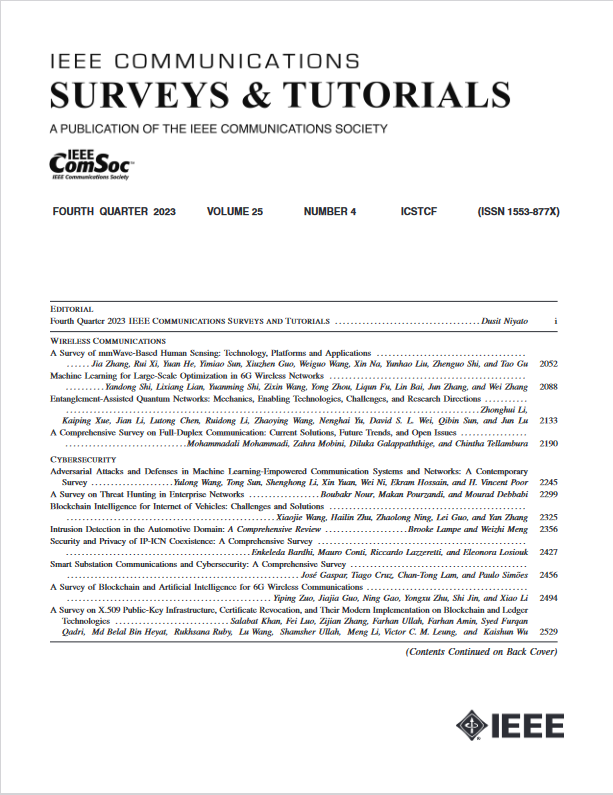高通量卫星通信系统的预编码:概览
IF 34.4
1区 计算机科学
Q1 COMPUTER SCIENCE, INFORMATION SYSTEMS
引用次数: 0
摘要
随着对高数据传输速率和广泛覆盖范围的需求不断扩大,高吞吐量卫星(HTS)通信系统正在成为未来通信时代的一项关键技术。然而,目前的频段越来越拥挤。在通信系统成熟到可以在更高频段上运行之前,解决方案是更有效地利用现有频段。在这种情况下,预编码成为提高频谱效率的有效方法之一。本调查报告从两个主要角度对近期用于 HTS 通信系统的预编码技术进行了概述和分类:1)问题提出的角度;2)系统设计的角度。从问题表述的角度,预编码技术按照预编码优化问题、组别和级别进行分类。从系统设计的角度来看,预编码根据系统架构、预编码实现和所提供服务的类型进行分类。此外,还讨论了实际的系统损伤,并介绍了稳健的预编码技术。最后,讨论了卫星预编码的未来趋势,以促进进一步的研究。本文章由计算机程序翻译,如有差异,请以英文原文为准。
Precoding for High-Throughput Satellite Communication Systems: A Survey
With the expanding demand for high data rates and extensive coverage, high throughput satellite (HTS) communication systems are emerging as a key technology for future communication generations. However, current frequency bands are increasingly congested. Until the maturity of communication systems to operate on higher bands, the solution is to exploit the already existing frequency bands more efficiently. In this context, precoding emerges as one of the prolific approaches to increasing spectral efficiency. This survey presents an overview and a classification of the recent precoding techniques for HTS communication systems from two main perspectives: 1) a problem formulation perspective and 2) a system design perspective. From a problem formulation point of view, precoding techniques are classified according to the precoding optimization problem, group, and level. From a system design standpoint, precoding is categorized based on the system architecture, the precoding implementation, and the type of the provided service. Further, practical system impairments are discussed, and robust precoding techniques are presented. Finally, future trends in precoding for satellites are addressed to spur further research.
求助全文
通过发布文献求助,成功后即可免费获取论文全文。
去求助
来源期刊

IEEE Communications Surveys and Tutorials
COMPUTER SCIENCE, INFORMATION SYSTEMS-TELECOMMUNICATIONS
CiteScore
80.20
自引率
2.50%
发文量
84
审稿时长
6 months
期刊介绍:
IEEE Communications Surveys & Tutorials is an online journal published by the IEEE Communications Society for tutorials and surveys covering all aspects of the communications field. Telecommunications technology is progressing at a rapid pace, and the IEEE Communications Society is committed to providing researchers and other professionals the information and tools to stay abreast. IEEE Communications Surveys and Tutorials focuses on integrating and adding understanding to the existing literature on communications, putting results in context. Whether searching for in-depth information about a familiar area or an introduction into a new area, IEEE Communications Surveys & Tutorials aims to be the premier source of peer-reviewed, comprehensive tutorials and surveys, and pointers to further sources. IEEE Communications Surveys & Tutorials publishes only articles exclusively written for IEEE Communications Surveys & Tutorials and go through a rigorous review process before their publication in the quarterly issues.
A tutorial article in the IEEE Communications Surveys & Tutorials should be designed to help the reader to become familiar with and learn something specific about a chosen topic. In contrast, the term survey, as applied here, is defined to mean a survey of the literature. A survey article in IEEE Communications Surveys & Tutorials should provide a comprehensive review of developments in a selected area, covering its development from its inception to its current state and beyond, and illustrating its development through liberal citations from the literature. Both tutorials and surveys should be tutorial in nature and should be written in a style comprehensible to readers outside the specialty of the article.
 求助内容:
求助内容: 应助结果提醒方式:
应助结果提醒方式:


